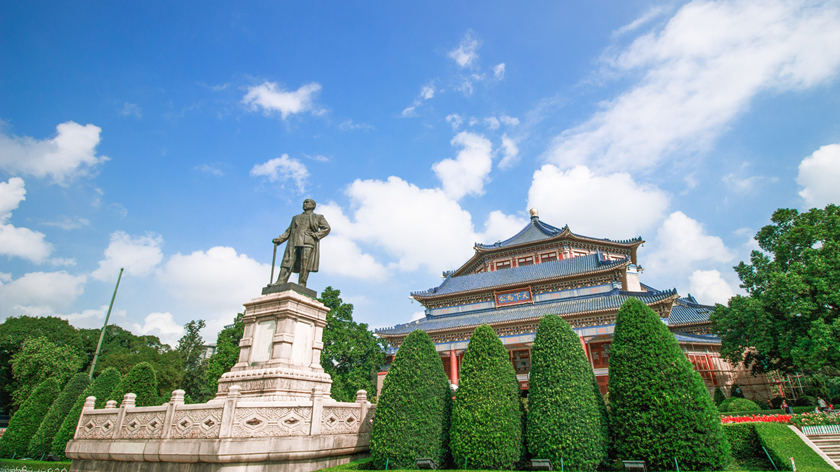Chinese Name: 孙中山纪念堂 Pronunciation: sūn zhōng shān jì niàn táng
Suggested Visiting Hours: 1-2 Hours
Occupied Area: About 8,400 square meters
Building Time: 1929
Admission Ticket Fare: Free (If you enter into the major hall, you need to pay 10 yuan.)
Building Function: Sun Yat-sen Memorial Hall was built in memory of Sun Yat-sen.
Best Visiting Season: Spring and Summer(March to May, June to August)
Address: No. 299, Dongfeng Middle Road, Yuexiu District, Guangzhou, Guangdong.
|
Park Gate
|
All Year(January 1st to December 31st)
|
|
| Opening Hours | 8:00-18:00 | |
| Ticket Office Opening Hours | 8:00-16:30 | |
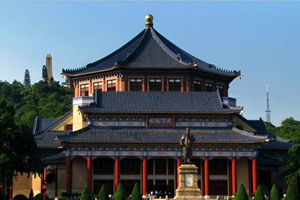
The Sun Yat-sen Memorial Hall is a commemorative building, funded by the people of Guangzhou and overseas Chinese in memory of Dr. Sun Yat-sen, a great pioneer of the democratic revolution. Initially built in January 1929, and finally accomplished in November 1931, it was extensively rebuilt in 1963 and the roof was made of blue glazed tiles. In 1956, a bronze statue of Dr. Sun Yat-sen which is 5 meters high stood in front of the memorial hall.
The memorial hall is octagonal, with solemn and grand appearance and strong national characteristics. The designer skillfully used the structural principle of architectural mechanics, adopted the mixed structure of steel frame and reinforced concrete, and there is no column in the building space with a span of 71 meters.
Sun Yat-sen Memorial Hall, a national AAAA tourist attraction, is a key cultural relics protection unit in Guangdong Province and China.
Sun Yat-sen was a great national hero, patriot, and pioneer of China’s democratic revolution. As the founder of the Republic of China, he advocated the Three Principles of the People and created the Constitution of Five Powers. He was born on November 12th, 1866, in Cuiheng Village, Xiangshan County, Guangdong Province. He once studied medicine in Hong Kong and became a Western medical doctor. After the Opium War, Sun Yat-sen witnessed the national crisis, and decided to abandon his medical career and involve himself in a political career. Sun Yat-sen was influenced by Zheng Guanying’s reform thought in his early days; later after seeing the corruption of the Qing government, he determined to overthrow the Qing Dynasty and establish a democratic republic. After the Revolution of 1911, he was elected as the Provisional President of the Republic of China from January 1, 1912 to April 1, 1912. Sun Yat-sen died of cancer in Beijing on March 12, 1925, aged 58. On June 1, 1929, he was buried at Sun Yat-sen Mausoleum on the Zijin Shan (Purple Mountain) of Nanjing, according to his last wish. In 1940, the Government of the Republic of China honored him as the “Father of the Republic of China”.
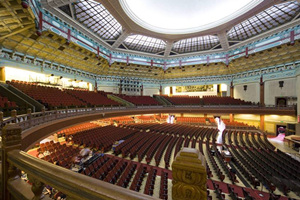
The memorial hall was originally the office of the president Sun Yat-sen. In 1922, it was ruined by fire. In 1928, Li Jishen organized to rebuild it, and the reconstruction started in January, 1929. Thanks to financial support of Li Jitang, it was finally accomplished in 1931.
The memorial hall is a major place of witnessing many mass gatherings. In 1936, Guangzhou people gathered here to hold No Smoking Parade. In May 1945, the Japanese aggressors in Guangzhou signed their surrender here. Additionally, a large number of important events were held here, such as the commemoration of the 100th Anniversary of President Mao's Birth.
The statue is in front of the memorial hall. In 1956, sculptors Yi Jichang created it, and the statue is 5.5 meters high and weighs 3.9 tons.
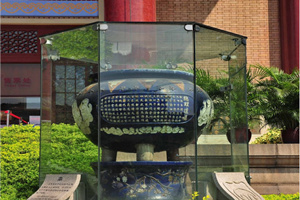
On both sides of the main entrance of the memorial hall, there is one ancient tripod for refuge on each side. They were fired on June 1, 1929 and October 10, 1930, respectively, with a history of nearly 80 years. According to reports, during the "Cultural Revolution", the words "Republic of China" on the two tripods were removed.
In order to avoid damaging the tripod, the old curator of the memorial hall buried them in the grass in the middle of the night to protect them as fertilizer pools for greening. After the cultural revolution, they were dug out and displayed to tourists.
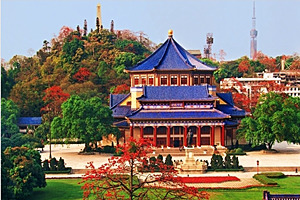
Few people would notice that walking along the bronze statue of Sun Yat-sen to the main gate, you will take two flights of stairs, which are nine steps and five steps respectively. In ancient China, numbers were usually divided into Yang number and Yin number. Odd number was Yang and even number was Yin. Nine is the highest in Yang number, and five is in the middle. Therefore, nine and five are often used to symbolize the authority of the emperor.
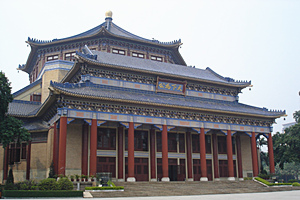
The hall building organically combines the Chinese traditional palace style with the Western reinforced concrete structure. There is no column in the space with a height of 47 meters and a span of 71 meters. It mainly relies on eight huge columns hidden between the walls to support a large steel truss with a span of 30 meters in four directions in the southeast and northwest, and then supports the main truss.
Xiaojing Tripod is located in just south of the Sun Yat-sen Mausoleum. It was cast by Jinling Arsenal. In 1929, Dai Jitao and all the students of National Sun Yat-sen University decided to donate money to cast a bronze tripod and put it in front of Sun Yat-sen Mausoleum after Dr. Sun Yat-sen was buried here.
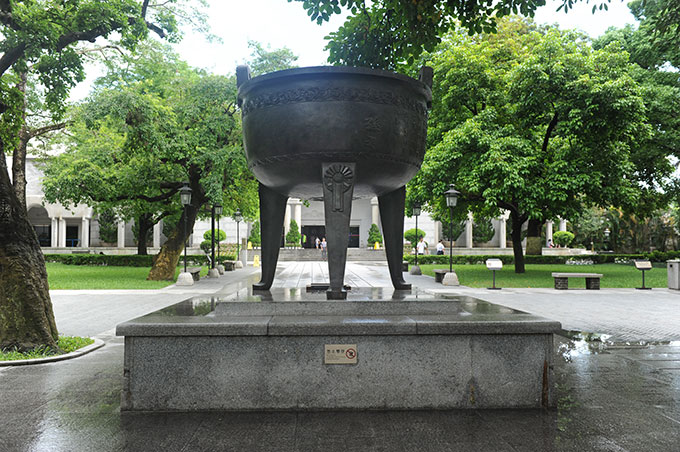
The tripod is made of bronze and has a unique shape. Structurally, it can be divided into three parts. The bottom is a bronze drum-shaped base decorated with patterns all over the body. A five-pointed star is engraved in the middle of the base, and the names of the design supervisor are engraved around the five-pointed star. The three feet of the bronze tripod are inlaid under the pedestal. The second part in the middle with a round abdomen is the main body of the bronze tripod. The north side of its abdomen is cast with the Chinese words, “wisdom, benevolence and courage”, written in Regular Script, while the south side is cast with the Chinese words, “loyalty, filial piety, benevolence, faithfulness and peace”, also written in Regular Script. Although these words have been worn away, traces can still be seen today. The lower part of the abdomen is cast with the words, “tribute of National Sun Yat-sen University” in Chinese written in Regular Script. There is a hexagonal pyramidal roofed pavilion with six columns and three eaves as the upper part of the tripod. The roof of the pavilion is covered with small tiles. There is a cuboid bronze monument in the pavilion, on which the full text of The Classic of Filial Piety (Xiaojing) handwritten by Mrs. Huang, Dai Jitao’s mother, is engraved. The whole tripod is 4.25 meters high, weighs about 5 tons, and the maximum diameter of its abdomen is 1.21 meters.
The stone platform where the tripod stands is octagonal with reinforced concrete inside and Suzhou granite on the surface. The stone platform is about three meters high and is divided into three layers. The lower layer is about 16 meters in diameter, the middle layer is 12.7 meters and the upper layer is 4 meters. Each layer of the stone platform is surrounded by fine carved granite railings. In the center of the stone platform, there is a round stone mound (also called tripod seat) carved from white marble, on which the bronze tripod is placed. The bronze tripod and the stone platform are a perfect match and cannot be separated.
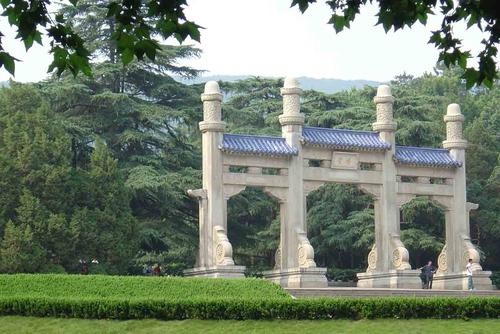
The memorial archway of Sun Yat-sen Mausoleum, also known as Bo’ai Archway, is the entrance of the mausoleum passage, through which those who pay homage to Dr. Sun Yat-sen must pass. The whole archway features a strong Chinese traditional style, which is 11 meters high and 17.3 meters wide, with three gates and four pillars.
The top of the archway is covered with blue glazed tiles. The archway is engraved with lotus petals, clouds, and ancient architectural painting patterns. On the transom of the middle gate of the archway, there is a stone tablet inscribed with the word, “Bo Ai” (universal love in English) in Dr. Sun Yat-sen’s calligraphy. Therefore, this archway is called Bo’ai Archway. Dr. Sun Yat-sen usually liked to write the two words as a gift for people. Nanjing is also known as the City of Universal Love.
The mausoleum gate is built in the center of the central axis of Sun Yat-sen Mausoleum, with a wide concrete platform in front of it, which can accommodate more than 10,000 people. There are manicured lawns on both sides of the platform. On the left and right lawns, there are ten ball-shaped boxwoods and six rare pines which are like umbrellas and extremely beautiful. Outside the mausoleum gate, there are semi-circular stone walls on both sides, which are connected with the walls of the mausoleum. On both sides of the mausoleum gate, there is a pair of white marble stone lions facing straight ahead with their mouths opening, and they are lifelike. With this pair of stone lions standing on the two sides separately, the mausoleum gate looks magnificent.
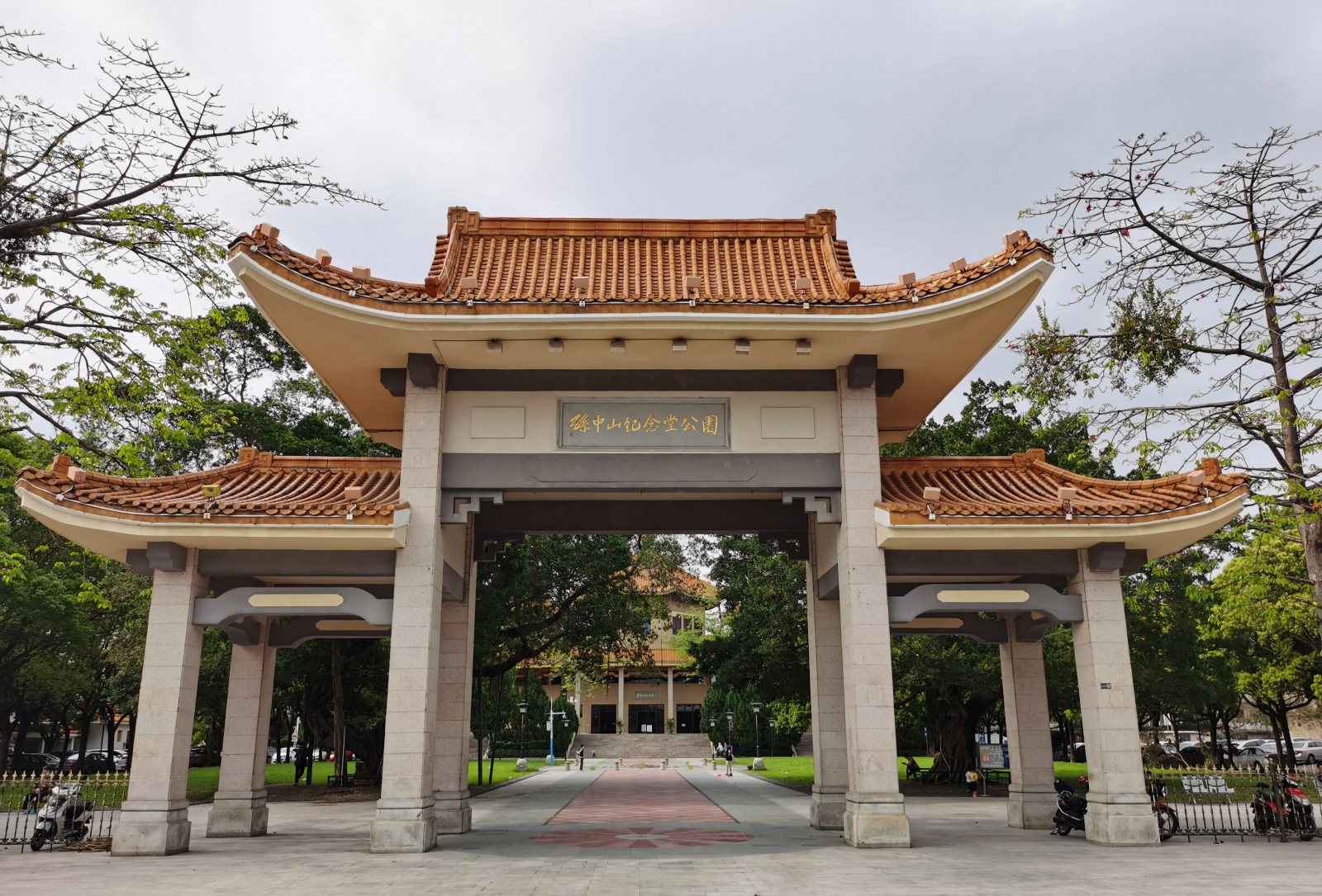
The mausoleum gate is built on a large cement platform, but it is much higher than the large platform. Visitors need to climb 20 granite steps to reach the mausoleum gate. It is rectangular, with a width of 24 meters, a depth of 8.8 meters and a height of 16.5 meters. It is a traditional wooden structure of ancient China, but it is all made of granite, and its patterns such as bucket arches, beams and square-columns are all exquisitely carved.
The roof of the mausoleum gate is a single-eave style, covered with blue glazed tiles. There are three archways in the gate, a larger one in the middle and two smaller ones on both sides. The three archways in the south mausoleum gate have door leaves while the three in the north have only door openings without door leaves. The upper part of the main entrance in the south mausoleum gate is inlaid with a square stone tablet engraved with four gold-plated Chinese characters, “Tian Xia Wei Gong”, which means the whole world as one community. This is Dr. Sun Yat-sen’s calligraphy, which is dignified and simple, magnificent and elegant.
The monument pavilion of Sun Yat-sen Mausoleum is built on the second platform behind the mausoleum gate. It is made of granite, with double eaves and covered with blue glazed tiles. It is a wooden structure imitating the ancient Chinese traditional construction style, with a height of 17 meters and a width of 12.2 meters, and its plane is approximately square.
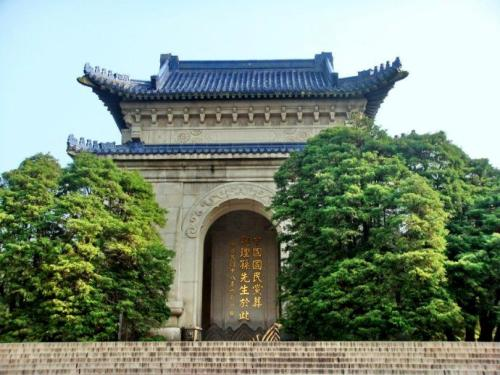
The tombstone is 9 meters high and weighs tens of tons. It is carved from an entire block of granite. When the tombstone was built that year, the tombstone materials were extensively solicited from various provinces across the country. A huge block of granite was selected by Fujian Province. When it was shipped, it was too large and extremely heavy, so it sank into the water shortly after loading on board. Therefore, people had to rush the second block of granite from Fujian to Nanjing. It took more than 40 days to move from Xiaguan Wharf in Nanjing to the foot of Purple Mountain step by step by manual rolling, and then from the foot of the mountain to the stele pavilion site on the hillside. This shows that the project was formidable at that time and the perseverance of the construction workers. The big stone tablet that people see in the tablet pavilion is made of the second block of granite from Fujian that year.
On March 18th, 1926, when the mausoleum project started, the Preparatory Committee for the funeral of Dr. Sun Yat-sen discussed the tombstone inscription in the pavilion. At that time, people prepared to chisel an inscription, an epitaph and the biography for Dr. Sun Yat-sen and made a division of labor. However, after nearly two years, the contents of these inscriptions have not been determined. On January 7, 1928, the Preparatory Committee held a meeting in Shanghai, concerning that Dr. Sun Yat-sen’s thoughts and achievements could not be summarized by words, so they decided not to use the inscriptions.
However, on March 7th, 1930, the Management Committee of the Prime Minister’s Cemetery clearly defined the content and writing format of the inscription. On the front of this large stone tablet, three lines of gold-plated inscriptions, which means “The Prime Minister of Chinese Kuo Min Tang Dr. Sun Yat-sen is buried here, June 1st, the 18th year of the Republic of China” in English, were engraved vertically from right to left, which is characterized by smooth strokes and rigorous structure, looking vigorous and powerful.
Don't wear high-heeled shoes. And visitors had better try to get to Sun Yat-sen Mausoleum as early as possible; otherwise, there will be more tour groups after 9: 00 in the morning.
It takes only 2 or 3 hours to climb the main peak of the Purple Mountain, Toutuoling, in the morning. When visitors go down the mountain, they can go directly to Sun Yat-sen Mausoleum. One day is enough for them to visit the Mausoleum.
Take bus 2, 27, 42, 56, 62, 74, 80, 83, 85, 185, 133, 204, 209, 224, 224A, 229 or 261 and get off at Sun Yat-sen Memorial Hall Station.
By Subway
Take Metro Line 2 and get off at the Memorial Hall Station.
By Taxi
Chinese: 请带我去孙中山纪念堂。English: Please take me to the Sun Yat-sen Memorial Hall.
If you go to the Sun Yat-sen Memorial Hall from Guangzhou Baiyun International Airport by taxi, it takes about 60 minutes (about 102 yuan).
If you go to the Sun Yat-sen Memorial Hall from Guangzhou South Railway Station by taxi, it takes about 40 minutes (about 85 yuan).
